Jennifer Hallock's Blog: Sugar Sun Series Extras, page 15
July 18, 2017
Sugar Sun extras: The Altarejos and Romero family trees

While I was drafting Under the Sugar Sun, I made character sketches and background briefers on the whole Altarejos and Romero family tree. Before I even knew the end of my book, I knew who this family was.

Let’s look at Javier’s household a little more closely, in the center lower portion of the family tree. Wait, you’re thinking, isn’t Javier an only child? If you remember, he is the only surviving child. Lourdes’s other three died at birth or in infancy—a tragedy that would have been all too common at this time. In Sugar Moon, we learn a little more:
The last delivery had been so traumatic that it almost killed the doña, too. Left with only one healthy son for all her effort, Lourdes had spoiled him with indiscriminate love until young Javier was hustled off to boarding school to grow up. When Javier returned home for his first vacation, he found a new little “sister” in the bedroom next to his.
That “little sister” is really his cousin, Allegra, the heroine of Sugar Moon. Her true story is not really even on this tree:

Early in Under the Sugar Sun, while Javier was flirting with Georgina at the Luneta, he explained that Allegra’s real father was a Spanish friar:
“My aunt never made a public accusation, of course. And my grandparents managed to marry their daughter off to a respectable, if not terribly intelligent, man. Unfortunately, even he could add. My aunt named the baby Allegra, hoping her husband would believe the child a miracle of rapid gestation. As you might imagine, their marriage was not a happy one.”
In fact, the marriage was so unhappy that Allegra’s mother, Raquel, ran off with a Spanish soldier. Horatio Alazas returned the child that wasn’t his to the Romeros—he had given Allegra a last name, and he believed his duty done. Lourdes took her sister’s child as her own, and that is how Allie ended up at Hacienda Altarejos. This whole backstory was inspired by a real Filipina friend of mine who raised not only her sister’s children, but one of their children, as well. Anything for family.

And then, of course, we have Padre Andrés. In Tempting Hymn it explains:
The biggest secret of the Altarejos clan, though, stood at the front of the nave: Padre Andrés was the late patriarch’s bastard son. Since the priest’s legitimacy was never openly questioned, neither was his ordination—but no one who looked at Don Javier and Padre Andrés side-by-side could miss the fact that they were brothers.
More about Andrés’s family will be coming in the upcoming Sugar Communion (expected 2018). I know this is eagerly anticipated by a few readers. I promise that I’m working on it!
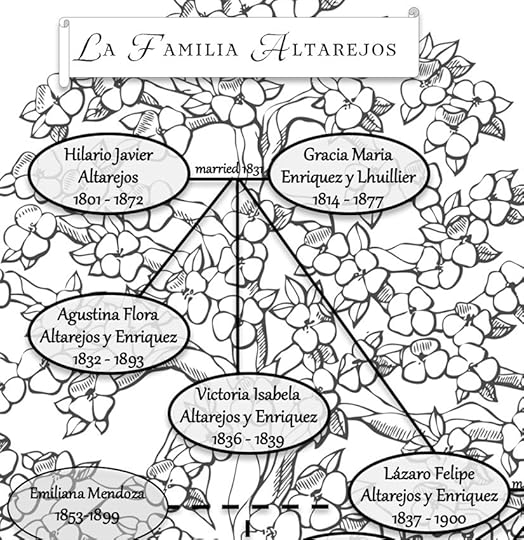
One day I might tell more about Lourdes and Lázaro’s marriage, but suffice it to say that Lázaro Altarejos came by adultery honestly. From Under the Sugar Sun:
[Javier] sat in the heavy wooden chair in his office and examined a painted miniature of his grandfather, the first Altarejos hacendero—though Altarejos was not even the Spaniard’s true name. When Capitan Hilario Vélez y Perales resigned his Army commission in Manila, he had balked at the idea of returning to his sowish wife and homely children in rural Altarejos, Spain, so he reinvented himself as an eligible feudal lord on the new frontier of sugar. Hilario “de Altarejos” eventually dropped the preposition from his nickname, won himself a thousand acres of virgin soil for saving the life of the alcalde-mayor, “married” a lovely mestiza who never knew that she was only a mistress, and planted himself a legacy.
That’s the Altarejos clan. Soon I will be making family trees for Javier and Georgina’s children…and more! I can’t wait.
I hope you have enjoyed this Sugar Sun extra. Find more here.
Sugar Sun extras: The books of Hacienda Altarejos
I should disclose that I minored in economics, so trade and business history is my jam. I got really into the weeds with my made-up documents, but it does prove something you might not expect about the hacenderos of yore: times were tough.
Even before the Americans arrived in 1898, Hacienda Altarejos took on debt to buy an expensive sugar mill—the one that Jonas Vanderburg fixes in Tempting Hymn. Of course, I had to make a bill of sale for the mill. How? Well, I found an advertisement from the Brisbane Courier and combined it with a receipt from Nambour, Queensland, and adjusted the numbers for inflation. Voilà, a sugar mill invoice from a real company that made them. (Scottish engineers were the thing at the time. They made all kinds of mills and mechanical equipment, even though sugar was not a local industry.)

Times got tougher on the hacienda. In addition to the Americans (below), there was a Rinderpest epidemic, which killed at least 75% of the carabao on Negros and other islands. (I found real articles about this while doing my research at Ateneo’s American Heritage Collection, but they were not digitized so I had to recreate them.)

Let’s look at Javier’s books. If you see the “emergency expenses” below, you can see the impact that rinderpest had on his bottom line. Where did I get such detailed financial information on sugar? The Far Eastern (Economic) Review, of course. (It has since shuttered, but this publication was a major source of my college research paper writing.) These averages might be a little off because they are from a different part of the Philippines (Pampanga), but they are still pretty good. Boy, did I learn a lot about sugar production in the Gilded Age.

All of these troubles put Javier in financial hot water, even before Ben Potter arrived on the scene. This is why he has to put up his land up as collateral for a loan to start off the 1902-1903 season. This money is mostly needed to pay for labor—and not very reliable labor, at that. According to contemporary sources, about half the workers of any given hacienda would disappear after they were paid their advance (anticipio). That’s expensive.
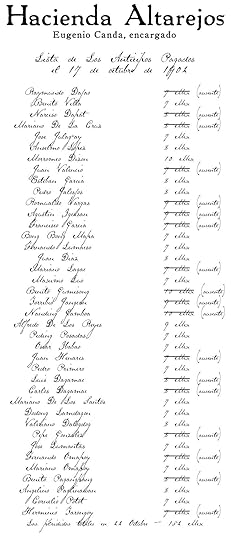
It is not a surprise, then, that Javier had money problems. The loan agreement he made with Guillermo Cuayzon, the pacto de retro, was a ruthless type of loan liquidation. (This was the device that allowed hacenderos to get rich in better times. Now it worked against Javier.)

Javier was skating a thin line at the start of the book. Sugar farmers in the early American period were not raking it in. Sure, they did in the 1880s and early 1890s, and they have on-and-off since. But the early 1900s were a crunch:
Javier leaned forward, hiding his clenched fists under the desk. “I don’t understand. We’re either a colony or we’re not. The Yankis don’t let us trade with the rest of the world, and now they shut us out of their home market, as well? Some ‘Open Door.’”
History had taught Javier to be a skeptic. In the last four years, everything that could go wrong had gone wrong. Sugar planters in Negros had sided with the Americans in the hope of keeping the peace, but their workers ran off into the hills to join the insurrectos. No labor, no harvest. The Americans punished the rebels by burning rice stores and closing the ports, but such draconian tactics ended up hurting men like Javier most of all. In the end, not only had a quarter of his crop rotted in the ground, but there had been no way to ship the harvested cane off the island. By the time the ports opened again, a freak rinderpest epidemic had killed most of the carabao. Replacing his herd put Javier so far in hock that he had been forced to put up a fifth of his land as collateral. And those were just his problems from last season.
As you can see from the exports below (real figures, by the way), sugar sales dropped dramatically with the arrival of the Americans. It does not improve until free trade is extended for sugar into the United States, a process which starts in 1909 and then is finalized in 1913. So, there is a happily ever after…eventually.

I hope you have enjoyed this Sugar Sun extra. Find more here.
Sugar Sun extras: Javier’s high school report card
For Javier’s report card, I researched elite education in the Spanish-era Philippines and the program at San Carlos in particular. Detailed biographies of José Rizal and issues of Solidaridad newspaper (out of Madrid) were very helpful. I even looked up the style of Spanish report cards. Grades were, from best to worst: sobresaliente (outstanding), notable (remarkable), bien (good), suficiente (sufficient), insuficiente (insufficient), and muy deficiente (very deficient).
Note: If you cannot read the print of the report card well, there are close-ups below.

You will notice that Javier was not a great student as a young, spoiled boy. Actually, he failed his first year! (See where it says “suspenso”? And see how the courses repeat from 1883-1884 to 1884-1885?) Eleven-year old Javito was not happy to leave his luxurious life as the only child of a prosperous hacendero to attend a strict Vincentian Catholic school. He was certainly ill-equipped for life on his own, as he recounts in Under the Sugar Sun:
[Javier] had not lifted a finger in his house until he left for boarding school. And he meant that—not a finger. What other boy would have gotten a skin rash from not rinsing off his soap? One who had never bathed himself before, that’s who.
Javier was also bullied at first by the older students. A miserable child does not study. This was the result:

As Javier grew and got used to school, though, his grades improved. He was a smart young man who simply needed to apply himself. (Wow, how many times have I written that on a real kid’s comment?) Javier will apply himself…until he gets caught sneaking out to a brothel (with half-brother Andrés in tow). Deciding that Javier needs to grow up, his father sends him to military school in Spain. From there, he makes his way to King’s College, London, where he earns a degree in law. These years in England (and later France!) give him the skills and experience to woo Georgina, so it all ends well.

More of the Altarejos brothers’ history will come to light in Sugar Communion (anticipated 2018), so stay tuned! I hope you’ve enjoyed this Sugar Sun extra. Find more here.
Sugar Sun extras: Georgina’s search for Ben
When I started my research for Under the Sugar Sun, I spent a lot of time in the microfiche room at Ateneo de Manila looking through the Manila Times. At first, I did not know what I was looking for. Inspiration, I suppose—and I found it in a real article entitled, “Sister Hunting for Brother: His Name Is E.L. Evans and He Is Supposed to Be in the Philippines.” The sister’s letter had been mis-delivered, and the recipient sent it on to the newspaper as a last-ditch effort to find the missing brother. And thus the Ben Potter and Balangiga story line was born. (And I know you don’t like him yet. You are not supposed to. But just wait. Sugar Moon is coming, and I think Ben will change your mind.)
Back in 2011, I rewrote the original article for Georgina and Ben. Yes, I was writing the book that long.
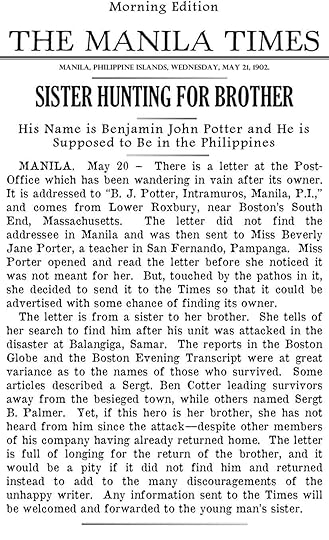
Now, you cannot totally blame Georgie for being worried. These were the real headlines from the Boston Daily Globe about what happened to his unit:
Disaster in Samar. American Troops Surprised at Balangiga. Forty Officers and Men Killed by Insurgents. Company C 9th Attacked While at Breakfast.
Death List. Names of Those Lost at Balangiga, Samar. Five of the Number Went from Boston to Philippines. Thirty-Five Killed and Died of Wounds. Eight Missing.
Nine Boston Men. Seven of Them Were Enlisted Men, and It Is Feared They were All Among the Lost at Balangiga.
Wounded at Balangiga: Boston Loses One More.
Enlisted men’s families were not sent a telegram when their loved ones died. Only officers’ next of kin were offered that peace of mind. Georgie would have combed these articles and found all sorts of discrepancies, as you can read above. This is based on the truth. When I compared the newspaper lists against the Company C roster, there were lots and lots of errors. Even the early Army reports had errors—no surprise, since they were the ones who gave names to the reporters. It was enough to drive a confused family crazy.
And it did not help to read letters like the one below. This is a real letter by a private at Balangiga who, before he died, wrote to his family in Boston about the worsening conditions of his unit. His family let the newspaper print the letter in full, and I can just imagine what Georgina and her mother thought. I recreated the article so that I could edit it down to its most salient points, but it is taken from a real article on this date and in this newspaper.

This letter really defines Georgina’s obsession with finding and, ultimately, returning her brother to Boston. She didn’t know she was a romance heroine, after all. She thought her life more Gothic-style mystery, I suppose. But she will figure out the truth—after a calesa ride or two!
I hope you have enjoyed these Sugar Sun extras. Find more here.
Sugar Sun extras: Spoilery documents
Okay, you have been warned.
If you’re still here, you know that Javier took control over Georgina’s search for Ben, heading off on his own to Catbalogan. This alpha male behavior infuriated Georgina. She then strong-armed Allegra and Lourdes to hand over the telegram messages that Javier sent to Lope Cuayzon, the merchant who is holding Ben. Those would have looked a lot like this (based on real receipts from the period):


Knowing Javier’s travel plans, Georgie followed him to Catbalogan. Javier found Ben, but he was a total wreck. The veteran was clearly suffering from what at the time would have been called “soldier’s heart,” or Post Traumatic Stress Disorder. We may understand this injury better now, but Georgina, like many at the time, would have considered it a type of homesickness. This is why she came to find him in the Philippines, and why she could not leave him there. As she explained to Javier:
“You would put the needs of Allegra and your mother above your own: you would travel to the edge of the earth to find them, live among strangers, humiliate yourself on a daily basis because you did not fit in no matter how much you tried—you would do all that for family, and you would not stop until you succeeded. You wouldn’t rest until they were safe.”
But Georgie did not realize how much Javier depended on her, too. His own debts plus Lope’s extortion pushed him to bankruptcy. (Does this sound like how John Thornton loses his factory in North and South? Yes, there was some inspiration there. Both heroes were noble men who are undone by a world beyond their control—John Thornton with the rapid changes of industrial labor conditions, and Javier Altarejos with the restrictive American trade laws…and the interference of an ambitious opium merchant.)
In the end, Hacienda Altarejos was put up for auction:

But Georgina did not know any of this. She and her brother were staying at the Hotel Oriente (yes, this Hotel Oriente) while she tried to arrange passage back to Boston. Since the finer hotels in Manila published lists of their guests (privacy, what?), I recreated a (true to form) front page of the business daily, the precursor of the Manila Bulletin:
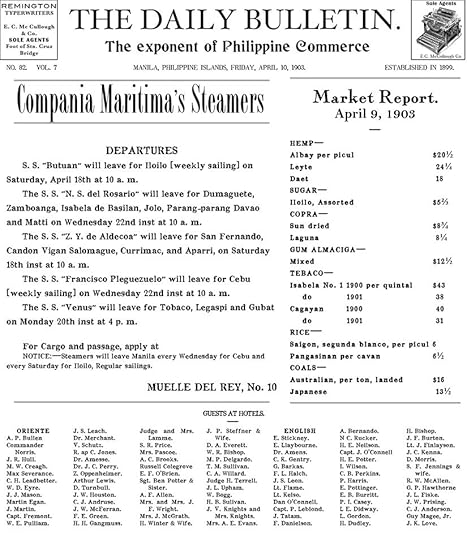
In case you cannot see the guests clearly enough, look at the third column on this close up:

In the end, Ben refused to leave the Philippines for reasons that will become clear in Sugar Moon (upcoming). He abandoned a pregnant Georgina at the Hotel Oriente—after stealing most of her money—which makes her finally realize that she had been protecting the wrong “family” after all. Though she is incredibly stubborn—oh boy!—she becomes stubborn for the right man now: Javier. That is a story worth telling, and the newspapers do! (These are based on real Manila gossip columns, by the way.)

And from the (long since defunct) Sunday Sun:
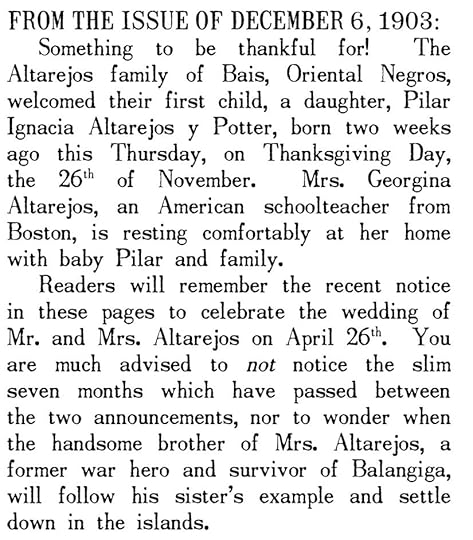
Meanwhile, the hacienda was saved by Padre Andrés Gabiana. He kept the land in the family by selling one of Lázaro Altarejos’s assets (Andrés’s mother’s house in Cebu) to pay off the debts on the other (the hacienda). Importantly, this means he no longer has to live at Javier’s indulgence as the curate of San Honorato chapel. He became his own boss! And if the idea of a priest-hacendero sounds problematic to you, the Church will agree. We will see his own drama unfold in Sugar Communion (anticipated 2018), with the help of a pretty American doctor. Stay tuned!
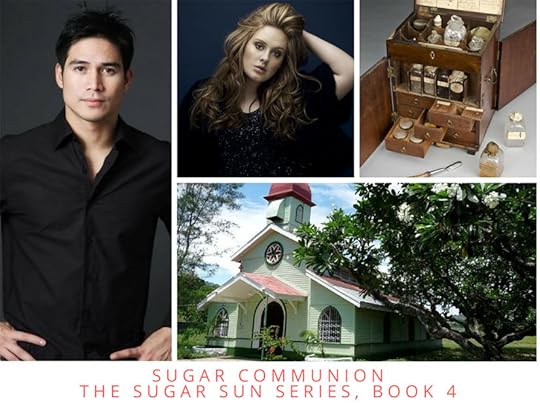 A little inspiration for the upcoming Sugar Communion: Piolo Pascual as Andrés Gabiana, Adele as Liddy Sheppard, Liddy’s mahogany medicine chest, and San Honorato on Hacienda Altarejos (really Mojon Chapel in Bais).
A little inspiration for the upcoming Sugar Communion: Piolo Pascual as Andrés Gabiana, Adele as Liddy Sheppard, Liddy’s mahogany medicine chest, and San Honorato on Hacienda Altarejos (really Mojon Chapel in Bais).I hope you have enjoyed these Sugar Sun spoilery extras. You can read more here.
July 14, 2017
Sugar Sun series location #8: Malecón
One thing that hasn’t changed in Manila since 1900 is the traffic. One anonymous visitor said about the end of the evening on the Luneta:
…there is a crack of the whip and a grand hurrah and one mad dash for the different homes. I wonder there are not dozen smash ups each afternoon, but there are not. I used to melt and close my eyes, expecting to be dashed into eternity any moment, but I have learned to like it, and I don’t want any one to pass me on the road.
We’ve all been there.
 A vintage postcard of the Malecón.
A vintage postcard of the Malecón.Some park goers did not wait for the end of the evening to race, though. With the old shoreline, the water went right up to the walls of Fort Santiago—or almost. There was a single open road there, called the Malecón, where carriages practically flew:
The two vehicles ate up the open road. Georgie did not consider herself a coward, but she was torn between fearing for the horses’ safety and for her own. Maybe sensing that, Javier put his arm around her shoulders, pulling her closer to his side. It was too cozy by half, but it steadied her enough to make the frenetic motion bearable.
The two nags kept changing the lead. One would break out in a small burst of speed, and then slow in recovery while the other made his move. They had at least a mile to go until the “finish” at Fort Santiago, and it seemed that Georgie’s original prediction was on the mark: the sole surviving animal would win. It was less a race than a gladiatorial bout.
You can find Malecón at location 5 on the map below. (These maps of Manila and the Visayas, which you can find in Under the Sugar Sun, were a suggestion of a faithful reader, Priscilla Lockney. Awesome, right?! But when I tried to find maps from before the port expansion that changed the shoreline—see the Luneta post for more on that—it was a challenge. I ended up making my own from a rare Spanish map reprinted in the Harper’s Pictorial History of the War with Spain, Volume II. I was almost as proud of these as I was of finishing the book.)
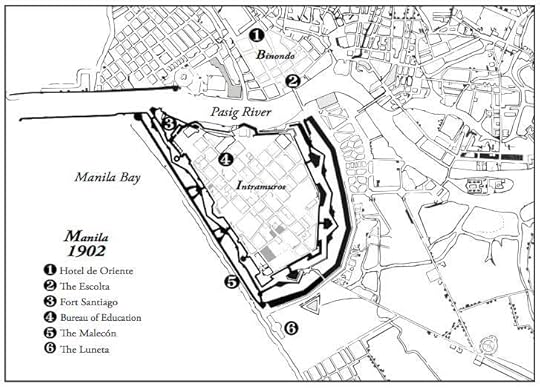
The Malecón ran from the Luneta along the bay, “under the yawning mouths of the old muzzle loaders” to Fort Santiago (see 3). It seems like a strange place for romance, but it was that, too. Maybe it was the electric lamp posts installed in 1893, part of a half a million peso city improvement project. Maybe it was the company:
[Georgina] looked up. This close, she could see honey-colored circles in [Javier’s] brown irises. They looked like rings on a tree. Did she see in them the same fire she felt, or was this a part of the show?
Gently Javier tilted her chin up, his lips now inches away. No one had ever tried to kiss her, not even Archie–his amorous attentions had all been by pen. She thought about resisting, but that was all it was, a thought. Javier’s breath was clean. Only the smallest bite of scotch lingered from lunch. Given her past, Georgie had never believed alcohol could be an aphrodisiac, but on this man the crisp scent was provocative. He smelled of confidence and power, yet his lips looked surprisingly soft—
—Under the Sugar Sun
Ha ha, I think I’m going to leave it there. You’re welcome.

July 11, 2017
Sugar Sun glossary terms in alphabetical order
At long last, an alphabetical listing of the Sugar Sun glossary terms! Simply click on the graphic of your choice to open the annotated post in a new window. This list will be updated to include new terms as their posts are written.
I hope the posts are helpful in rounding out the historical context of the Sugar Sun series. They are certainly fun to write! Enjoy.
July 9, 2017
The Sugar Sun series locations
Want to learn more about the setting of the Sugar Sun series? Click on any of the graphics below. Enjoy your visit!
 Sugar country founded by Spanish & Chinese mestizos in the 19th century. Come for whale sharks, stay for the pretty.
Sugar country founded by Spanish & Chinese mestizos in the 19th century. Come for whale sharks, stay for the pretty. Beaches, mountains, sugar, missionaries, & sinners. This town is still one of my favorite cities in the Philippines.
Beaches, mountains, sugar, missionaries, & sinners. This town is still one of my favorite cities in the Philippines. The Fifth Avenue of old Manila, a place to buy harness and hardware, dry goods and diamonds, and more.
The Fifth Avenue of old Manila, a place to buy harness and hardware, dry goods and diamonds, and more. While you’re on the Escolta, don’t forget to get some ice cream, fresh bread, or delicious coffee at Clarke’s.
While you’re on the Escolta, don’t forget to get some ice cream, fresh bread, or delicious coffee at Clarke’s. Learn about the real Moss & Della: manager West Smith & wife Stella of the troubled, faded glory Hotel Oriente.
Learn about the real Moss & Della: manager West Smith & wife Stella of the troubled, faded glory Hotel Oriente. The place to see and be seen in old Manila. Mosquito free! Then the Americans went and ruined it.
The place to see and be seen in old Manila. Mosquito free! Then the Americans went and ruined it. This town is a case study in occupation & a name that every American should know. Essential reading for the upcoming novel, Sugar Moon.
This town is a case study in occupation & a name that every American should know. Essential reading for the upcoming novel, Sugar Moon.There will be more locations coming, so stay tuned! Thanks for reading.
July 6, 2017
Steamy Reads Live!
Tamsen Parker, Jen Doyle, Sionna Fox, and I will be Reading It Hot next week, Thursday, July 13th, at 7:30pm at Laney & Lu Café in Exeter, New Hampshire. Free nibbles, wine, and steamy reads in a range of genres: erotic, contemporary, paranormal, and historical romance! Click on the image below to go to the Facebook event page. We hope to see you there!
Last week icymi…
The #romanceclass community, a group of talented English-language romance authors in the Philippines, did a #FeelsSoHot event at Commune Café & Bar in Makati. They have organized many similar reading events—with pairs of professional actors reading the scenes!—but this was their first steamy read. I was honored that they included Under the Sugar Sun in the playlist. This moment in the reading almost killed me:
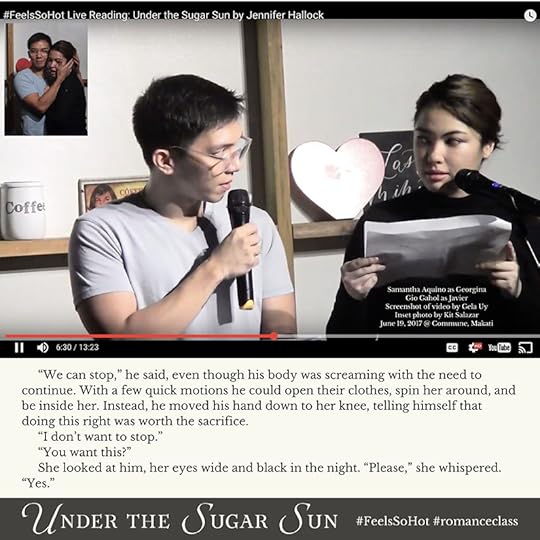
The excerpt they chose started with this scene of Javier and Georgina on the hacienda, and I got such chills from it that I turned it into a #ThursdayBookTease graphic. The theme today was FEELS, so I think it did the trick!
I hope you’ve enjoyed the #teasers, and if you are in the New England area, I hope you can join us at #ReadItHot!
June 28, 2017
Guide to the history behind Sugar Sun
At the start of Under the Sugar Sun, Georgina Potter travels to the Philippines to search for her brother, Ben—a soldier missing since the Philippine-American War. The very night she arrives, she walks into a fire set by the cholera police to “cleanse” a neighborhood. Right away we are rooted into the history of the American colonial period.
But why were Americans in the Philippines in the first place? How did war with Spain turn into an empire in Asia?
Here on my blog, I have written a lot of history—no surprise since it is my day job. Here are links to the most relevant posts, complete with illustrations.
 What was so “new” about American imperialism in the Philippines? Also, how Mark Twain is still relevant today. Find out more.
What was so “new” about American imperialism in the Philippines? Also, how Mark Twain is still relevant today. Find out more. American imperialism was a cause and effect of the Spanish-American War. Why fight at all? It’s the economy, stupid! Find out more.
American imperialism was a cause and effect of the Spanish-American War. Why fight at all? It’s the economy, stupid! Find out more.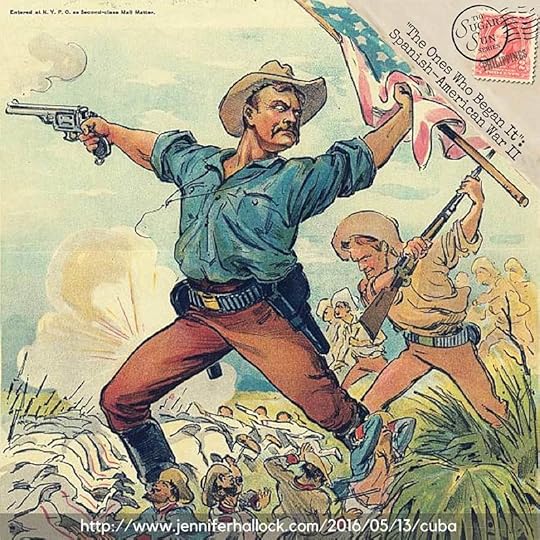 Navy accidents, fake news, and a New Yorker bent on war. Of course, I mean the Spanish-American War of 1898. Find out more.
Navy accidents, fake news, and a New Yorker bent on war. Of course, I mean the Spanish-American War of 1898. Find out more. Mission creep was a thing before we had the phrase. How the war with Spain turned into an empire in Asia. Well, sorta. Find out more.
Mission creep was a thing before we had the phrase. How the war with Spain turned into an empire in Asia. Well, sorta. Find out more. The good, bad, and ugly of your great-great-great grandparents’ Vietnam War. And why it matters to you now. Find out more.
The good, bad, and ugly of your great-great-great grandparents’ Vietnam War. And why it matters to you now. Find out more. Cholera has long been a casualty of war. To Americans it was challenge to modernity & “benevolent assimilation.” Find out more.
Cholera has long been a casualty of war. To Americans it was challenge to modernity & “benevolent assimilation.” Find out more. Learn about the real missionaries of Dumaguete, the backdrop for Tempting Hymn, and their best legacy: Silliman University. Find out more.
Learn about the real missionaries of Dumaguete, the backdrop for Tempting Hymn, and their best legacy: Silliman University. Find out more. A case study in occupation, and a town that every American should know. Essential reading for the upcoming Sugar Moon. Find out more.
A case study in occupation, and a town that every American should know. Essential reading for the upcoming Sugar Moon. Find out more.I hope you have enjoyed my particular snarky view of history, and I hope it enriches your reading of the Sugar Sun series:
Serious history. Serious sex. Happily ever after.
Sugar Sun Series Extras
- Jennifer Hallock's profile
- 38 followers






































